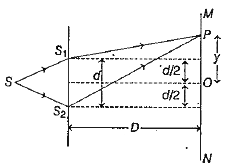Deduce an expression for the fringe width in Young.s double slit experiment. How does the fringe width depend on the distance between the source and the slits?
The experimental arrangement for Young.s double slit experiment is shown in the figure.

Consider a point P at a distance y from 0, the centre of screen.
The path difference between two waves arriving at P is equal to S2P−S1P.
Now, (S2P)2−(S1P)2
=[D2+(y+d2)2]−[D2+(y−d2)2]=2yd
Thus, S2P−S1P=2ydS2P+S1P
But, S2P+S1P=2D
∴S2P−S1P=dyD
(i) For constructive interference (Bright fringes, i.e. maxima)
path difference =dyD=nλ, where n=0,1,2,3,...
∴y=nDλd(∵n=0,1,2,3,...)
Hence, for n=0,y0=0 at O central bright fringe.
For n=1,y1=Dλd for 1st bright fringe
For n=2,y2=2Dλd for 2nd bright fringe
For n=n,yn=nDλd for nth bright fringe
The separation between. two consecutive bright fringes is
β=nDλd−(n−1)Dλd=Dλd⇒β=Dλd
(ii) For destructive interference (dark fringes, i.e. minima)
Path difference =dyD=(2a−1)λ2
or n=1,y1=Dλ2d for 1st dark fringe
For n=2,y2=3Dλ2d for 2nd dark fringe
for n=n,yn=(2n−1)Dλ2d for nth dark fringe.
The separation between two consecutive dark fringes is
β.=(2n−1)Dλ2d−{2(n−1)−1}Dλ2d=Dλd⇒β.=Dλd
Thus, all bright and dark fringes are of equal width. From the above relation, fringe width (β) is directly proportional to the distance between the source and the slits (D)
Similar Questions
Find out the expression for Fringe width in Young's double' slit' 'experiment.
View SolutionThe graph between the separation of the slits and fringe width in Young.s double slit experiment is (assume that the distance between the source and the screen and the wavelength of the source are kept constant)
View Solution
Knowledge Check
- Question 1 - Select One
The fringe width in Young’s double slit experiment increases when
AWavelength increasesBDistance between the slits increasesCDistance between the source and screen decreasesDThe width of the slits increases - Question 2 - Select One
In the Young’s double slit experiment, for which colour the fringe width is least
ARedBGreenCBlueDYellow - Question 3 - Select One
If the frequency of the source is doubled in Young's double slit experiment, then fringe width (β) will be –
AunchangedBβ/2C2βD3β
How does the fringe width, in Young's double-slit experiment, change when the distance of separation between the slits and screen is doubled ?
View SolutionHow does the fringe width, in Young's double-slit experiment, change when the distance of separation between the slits and screen is doubled ?
View SolutionIn the Young’s double slit experiment, for which colour the fringe width is least
View SolutionIn young's double slit experiment, fringe order is represented by m, then fringe width is
View SolutionIn young's double slit experiment, fringe order is represented by m, then fringe width is
View Solution
